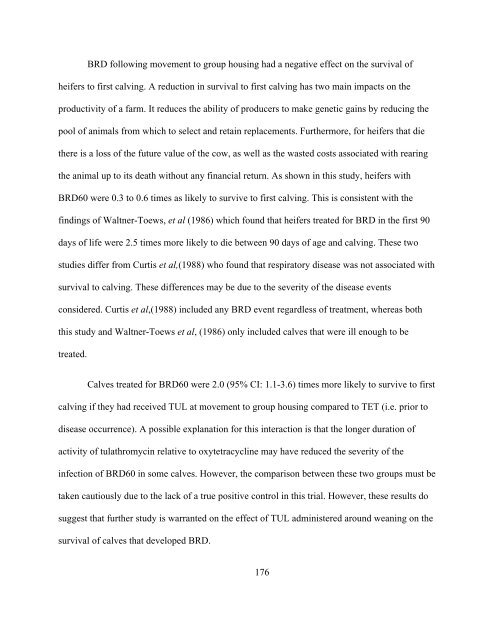Stanton PhD Thesis final_docx - Atrium - University of Guelph
Stanton PhD Thesis final_docx - Atrium - University of Guelph
Stanton PhD Thesis final_docx - Atrium - University of Guelph
You also want an ePaper? Increase the reach of your titles
YUMPU automatically turns print PDFs into web optimized ePapers that Google loves.
BRD following movement to group housing had a negative effect on the survival <strong>of</strong><br />
heifers to first calving. A reduction in survival to first calving has two main impacts on the<br />
productivity <strong>of</strong> a farm. It reduces the ability <strong>of</strong> producers to make genetic gains by reducing the<br />
pool <strong>of</strong> animals from which to select and retain replacements. Furthermore, for heifers that die<br />
there is a loss <strong>of</strong> the future value <strong>of</strong> the cow, as well as the wasted costs associated with rearing<br />
the animal up to its death without any financial return. As shown in this study, heifers with<br />
BRD60 were 0.3 to 0.6 times as likely to survive to first calving. This is consistent with the<br />
findings <strong>of</strong> Waltner-Toews, et al (1986) which found that heifers treated for BRD in the first 90<br />
days <strong>of</strong> life were 2.5 times more likely to die between 90 days <strong>of</strong> age and calving. These two<br />
studies differ from Curtis et al,(1988) who found that respiratory disease was not associated with<br />
survival to calving. These differences may be due to the severity <strong>of</strong> the disease events<br />
considered. Curtis et al,(1988) included any BRD event regardless <strong>of</strong> treatment, whereas both<br />
this study and Waltner-Toews et al, (1986) only included calves that were ill enough to be<br />
treated.<br />
Calves treated for BRD60 were 2.0 (95% CI: 1.1-3.6) times more likely to survive to first<br />
calving if they had received TUL at movement to group housing compared to TET (i.e. prior to<br />
disease occurrence). A possible explanation for this interaction is that the longer duration <strong>of</strong><br />
activity <strong>of</strong> tulathromycin relative to oxytetracycline may have reduced the severity <strong>of</strong> the<br />
infection <strong>of</strong> BRD60 in some calves. However, the comparison between these two groups must be<br />
taken cautiously due to the lack <strong>of</strong> a true positive control in this trial. However, these results do<br />
suggest that further study is warranted on the effect <strong>of</strong> TUL administered around weaning on the<br />
survival <strong>of</strong> calves that developed BRD.<br />
176

















